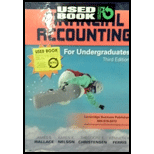
(a)
Prepare
(a)
Explanation of Solution
Bonds: Bonds are long-term promissory notes that are represented by a company while borrowing money from investors to raise fund for financing the operations.
Bonds Payable: Bonds payable are referred to long-term debts of the business, issued to various lenders known as bondholders, generally in multiples of $1,000 per bond, to raise fund for financing the operations.
Premium on bonds payable: It occurs when the bonds are issued at a high price than the face value.
Prepare journal entry for cash proceeds from the issuance of the bonds.
| Date | Account Title and Explanation | Debit ($) | Credit ($) | |||
| Cash | 430,887 | |||||
| Premium on Bonds Payable (1) | 30,887 | |||||
| Bonds Payable | 400,000 | |||||
| (To record issue of bonds at premium) | ||||||
Table (1)
- Cash is an asset and it is increased. So, debit it by $430,887.
- Premium on Bonds Payable is an adjunct liability account and it is increased. So, credit it by $30,887.
- Bonds payable is a liability and it is increased. So, credit it by $400,000.
Working note:
Calculate premium on bonds payable.
(b)
To prepare: Journal entry to record first semiannual interest payment and amortization of bond premium on June 30, 2015.
(b)
Explanation of Solution
Bonds: Bonds are long-term promissory notes that are represented by a company while borrowing money from investors to raise fund for financing the operations.
Bonds Payable: Bonds payable are referred to long-term debts of the business, issued to various lenders known as bondholders, generally in multiples of $1,000 per bond, to raise fund for financing the operations.
Premium on bonds payable: It occurs when the bonds are issued at a high price than the face value.
Straight-line amortization method: It is a method of bond amortization that spreads the amount of the bond discount equally over the interest period.
Prepare journal entry for first semiannual interest payment and amortization of discount on bonds.
| Date | Account Title and Explanation | Debit ($) | Credit ($) | |||
| 2015 | Interest Expense (4) | 20,911 | ||||
| June | 30 | Premium on Bonds Payable (2) | 3,089 | |||
| Cash (3) | 24,000 | |||||
| (To record first semiannual payment of interest on bonds) | ||||||
Table (2)
- Interest expense is an expense and it decreases the equity value. So, debit it by $20,911.
- Premium on Bonds Payable is an adjunct liability account and it is decreased. So, debit it by $3,089.
- Cash is an asset and it is decreased. So, credit it by $24,000.
Working notes:
Calculate premium on bonds payable semiannually.
Calculate the amount of cash interest.
Calculate the interest expense on the bond.
(c)
To prepare: Journal entry to record second interest payment and amortization of bond discount on December 31, 2015.
(c)
Explanation of Solution
Bonds: Bonds are long-term promissory notes that are represented by a company while borrowing money from investors to raise fund for financing the operations.
Bonds Payable: Bonds payable are referred to long-term debts of the business, issued to various lenders known as bondholders, generally in multiples of $1,000 per bond, to raise fund for financing the operations.
Premium on bonds payable: It occurs when the bonds are issued at a high price than the face value.
Straight-line amortization method: It is a method of bond amortization that spreads the amount of the bond discount equally over the interest period.
Prepare journal entry for second semiannual interest payment and amortization of discount on bonds.
| Date | Account Title and Explanation | Debit ($) | Credit ($) | |||
| 2015 | Interest Expense (7) | 20,911 | ||||
| December | 31 | Premium on Bonds Payable (5) | 3,089 | |||
| Cash (6) | 24,000 | |||||
| (To record first semiannual payment of interest on bonds) | ||||||
Table (2)
- Interest expense is an expense and it decreases the equity value. So, debit it by $20,911.
- Premium on Bonds Payable is an adjunct liability account and it is decreased. So, debit it by $3,089.
- Cash is an asset and it is decreased. So, credit it by $24,000.
Working notes:
Calculate premium on bonds payable semiannually.
Calculate the amount of cash interest.
Calculate the interest expense on the bond.
Want to see more full solutions like this?
Chapter 10 Solutions
FINANCIAL ACCT.F/UNDERGRADS-W/ACCESS

 AccountingAccountingISBN:9781337272094Author:WARREN, Carl S., Reeve, James M., Duchac, Jonathan E.Publisher:Cengage Learning,
AccountingAccountingISBN:9781337272094Author:WARREN, Carl S., Reeve, James M., Duchac, Jonathan E.Publisher:Cengage Learning, Accounting Information SystemsAccountingISBN:9781337619202Author:Hall, James A.Publisher:Cengage Learning,
Accounting Information SystemsAccountingISBN:9781337619202Author:Hall, James A.Publisher:Cengage Learning, Horngren's Cost Accounting: A Managerial Emphasis...AccountingISBN:9780134475585Author:Srikant M. Datar, Madhav V. RajanPublisher:PEARSON
Horngren's Cost Accounting: A Managerial Emphasis...AccountingISBN:9780134475585Author:Srikant M. Datar, Madhav V. RajanPublisher:PEARSON Intermediate AccountingAccountingISBN:9781259722660Author:J. David Spiceland, Mark W. Nelson, Wayne M ThomasPublisher:McGraw-Hill Education
Intermediate AccountingAccountingISBN:9781259722660Author:J. David Spiceland, Mark W. Nelson, Wayne M ThomasPublisher:McGraw-Hill Education Financial and Managerial AccountingAccountingISBN:9781259726705Author:John J Wild, Ken W. Shaw, Barbara Chiappetta Fundamental Accounting PrinciplesPublisher:McGraw-Hill Education
Financial and Managerial AccountingAccountingISBN:9781259726705Author:John J Wild, Ken W. Shaw, Barbara Chiappetta Fundamental Accounting PrinciplesPublisher:McGraw-Hill Education





